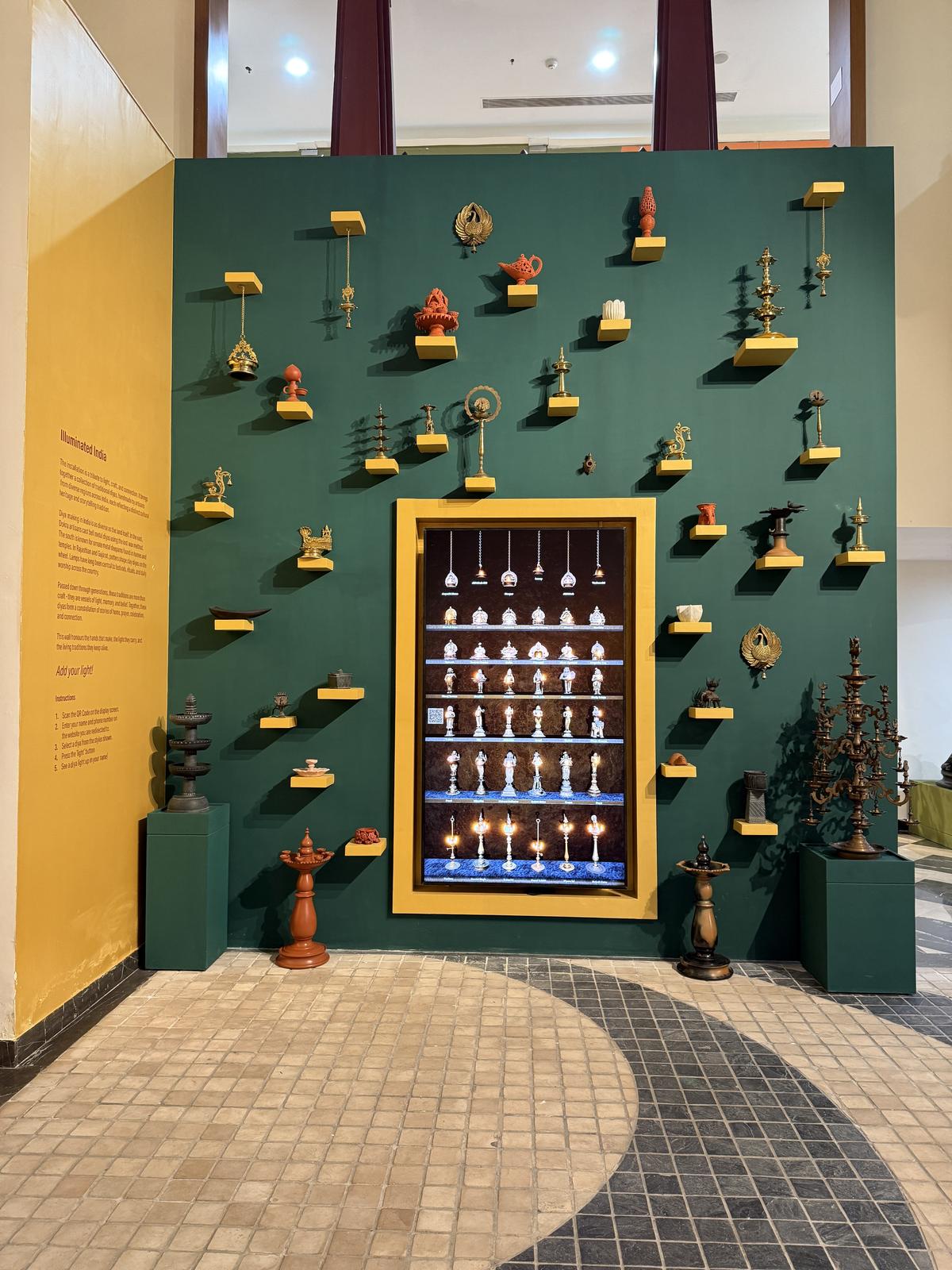For centuries, India’s artisans have carried memory in their hands — from the patient stitches of chikankari to the shimmer of thewa jewellery, or handwoven durries that hold entire stories. These creations have been displayed in museums or stores but rarely given a home that honours both process and product.

The Kunj in Delhi
| Photo Credit:
Special Arrangement
The Kunj, newly opened in Delhi’s Vasant Kunj, attempts to change that. Conceived by the Ministry of Textiles through the Office of the Development Commissioner (Handicrafts) and curated by cultural enterprise Cultre, it is a space where craft is not framed as a relic of the past but as a living, evolving practice. It brings artisans, designers, and audiences into conversation, creating an environment where tradition and innovation meet on equal terms. “Indian craft is so rich that we wanted a well-curated place which shows the best of Indian handicrafts to the world but is design-led,” says Amrit Raj, Development Commissioner (Handicrafts). “That is how this space has been conceptualised, and I hope people like what we have tried to present.”
Craft as living heritage
The most arresting corner of The Kunj is Karigar Sangam, where National awardees, Shilp Gurus, and Padma Shri artisans present their finest works. Among them, Abdul Baseer’s camel bone carving — an intricate hunting scene that took a year to complete — sits beside Sakila Bano Ansari’s chikankari khanposh, its jaali embroidery as airy as breath.
Dinesh Kumar Soni’s pichwai of Shrinathji glows with gold and silver leaf, echoing Nathdwara’s devotional traditions. And in a contemporary turn, Imtiyaz Ahmad’s Mirzapur durrie — woven over six months — translates faces and figures into bold colours and flat textures.

Visitors at The Kunj in Delhi
| Photo Credit:
Special Arrangement
Each piece carries its own story, allowing visitors to encounter the human voice behind the object and even purchase the work. For many artisans, such direct encounters are rare; too often, their creations are filtered through middlemen or displayed without context.
Shops with stories
Beyond Karigar Sangam, The Kunj hosts over 19 curated retail spaces, with more likely to open in the future. These are not uniform storefronts but intimate, thoughtfully designed shops carrying clothing, textiles, accessories, toys, and homeware. Here, established craft enterprises like Central Cottage Industries Emporium and Khamir sit alongside design-forward start ups such as IRO IRO and Mirasi, creating a marketplace that values authenticity as much as innovation.
There is also Khel Ghar where visitors can rediscover the joy of traditional Indian games and toys — handmade gilli danda, spinning tops, and chessboards that once defined everyday play. The idea is to move beyond souvenirs and into lived culture: craft as something to wear, to use, to gift, and to pass down.

The Kunj in Delhi
| Photo Credit:
Special Arrangement
Craft as experience
The Kunj is not built on the logic of passive consumption. Instead, it insists that craft is best understood through participation. At Kala Manch, lesser-known traditions rarely seen on National platforms take centre stage. In one corner, Amrita Devi’s sikki grass craft glows in gold and colour — boxes, toys, and jewellery made from strands of grass dried for nearly a month before weaving. Nearby, Ashutosh Verma’s sanjhi art, the devotional paper-cutting tradition of Mathura, draws from patterns once used to adorn temple floors in memory of Radha and Krishna.
Kalp Kosh takes this further, offering hands-on workshops where children and adults can learn a stitch, a fold, or a weave. The atrium itself holds a monumental installation by artist Ankon Mitra, woven from a hundred saris, transforming fabric into a sculptural landscape. The Hand-Crafted Garden, designed with bamboo, jute, terracotta, and cane, brings craft into architecture, offering a sensory pause amid the bustle. Even the colours of the interiors — deep, vibrant, and earthy — echo the exuberance of India’s handmade traditions.
The Kunj in Delhi
| Photo Credit:
Special Arrangement
“What makes craft relevant for younger audiences is when they can interact with artisans and see their practices placed alongside contemporary design. Otherwise, it’s just something they’ve only seen in their parents’ drawing rooms,” says Sunil Sethi, Chairman of the Fashion Design Council of India (FDCI). “When tradition is presented in dialogue with the present, it doesn’t just preserve the past — it actively shapes our future,” he adds.
Beyond a market
The Kunj positions itself not as a shopping arcade but as a cultural hub. Recently, FDCI organised Legacy of Craft, a fashion showcase where designers Divyam Mehta, Payal Jain, Samant Chauhan, Suket Dhir, and Upāvita drew directly from hand techniques — kantha, chikankari, Bhagalpuri silk, block prints, and Chanderi — to present collections that bridge heritage and contemporary fashion.
The Kunj in Delhi
| Photo Credit:
Special Arrangement
“Through this show, the audience not only witnessed the beauty of handcrafted textiles but also experienced how the crafts on display continue to inspire design, music, and performance unfolding alongside them,” adds Sunil.
India’s crafts have long been celebrated abroad, often more vigorously than at home. The Kunj is an attempt to root that celebration in Delhi, offering artisans both dignity and visibility, and audiences a deeper connection to the handmade.
Published – September 11, 2025 01:16 pm IST























